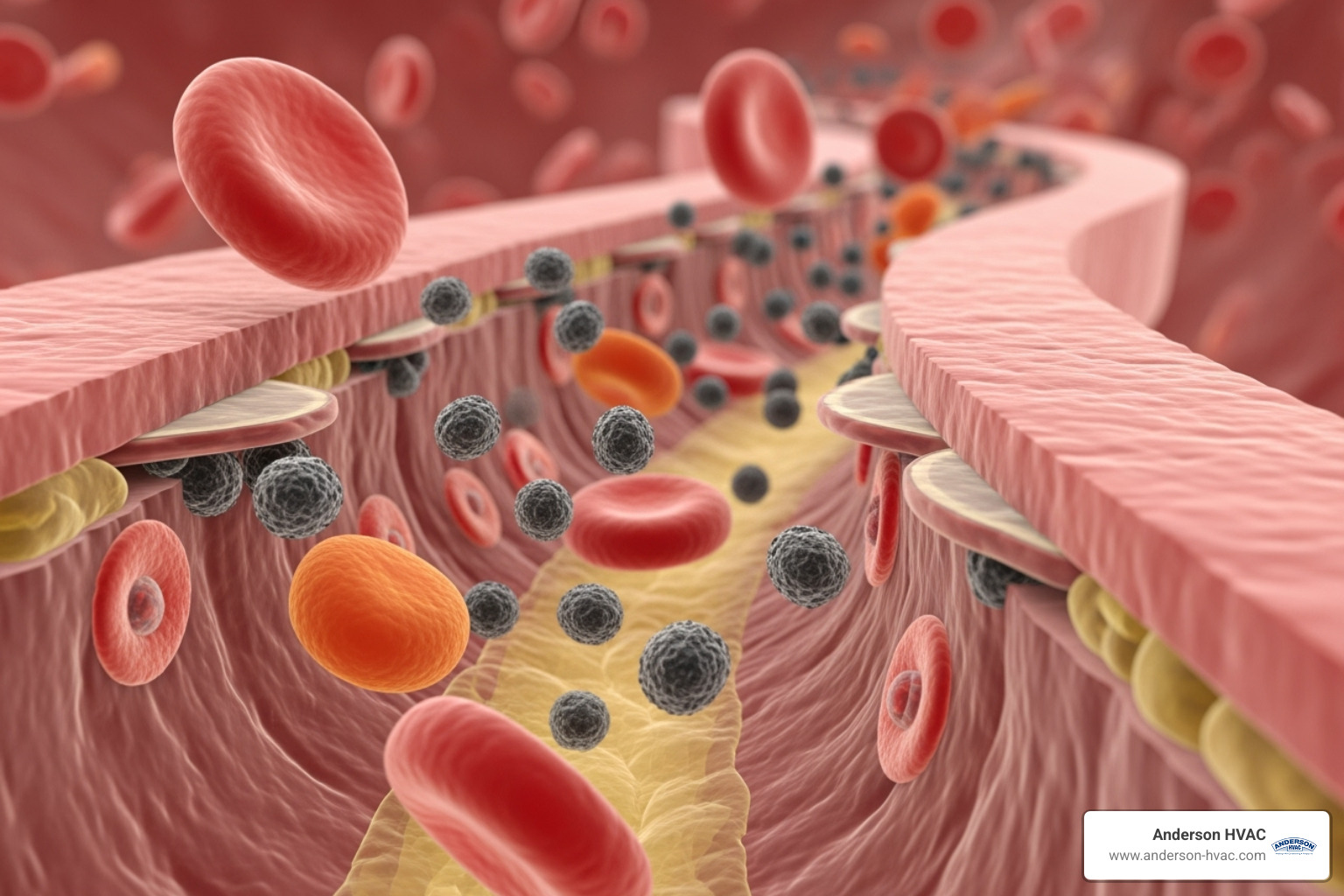Why Air Quality Management Matters for Your Home and Health
Air quality management is the process of protecting human health and the environment from air pollution. It involves monitoring pollutants, setting safety standards, and implementing control strategies to keep the air we breathe safe.
According to the World Health Organization, air pollution is the biggest environmental risk to human health, causing around 7 million premature deaths worldwide each year. In North Ogden, UT, we face both outdoor pollution from traffic and industry and indoor air quality challenges from household activities. Poor air quality is linked to increased heart and breathing problems, more emergency room visits, and serious long-term health conditions.
The good news is you can take action to protect your family. While large-scale air quality initiatives address outdoor pollution, understanding air quality management helps you control the air inside your home. Simple changes to your home’s ventilation and filtration can make a measurable difference in your family’s health. Ready to improve your indoor air? Contact Anderson HVAC today.
The Unseen Threat: Health and Environmental Impacts of Air Pollution
While we can’t see most air pollutants, they pose a serious threat to our health. The World Health Organization states that air pollution is the single biggest environmental risk to human health, contributing to about 7 million premature deaths annually.
The toll on human health is staggering. Exposure to poor air quality is linked to increased heart and breathing problems, including stroke, lung cancer, and chronic obstructive pulmonary disease (COPD). One of the most dangerous culprits is fine particulate matter (PM2.5). These microscopic particles can penetrate deep into your lungs and enter your bloodstream, affecting nearly every organ.
Children are especially vulnerable. Prenatal exposure to air pollution can lead to developmental delays and behavioral problems later in childhood, making effective air quality management critical for the next generation.
The environment also suffers. Air pollution reduces crop yields, weakens forests, contaminates water, and damages buildings. Some pollutants are also greenhouse gases, creating a vicious cycle that worsens climate change and air quality. The economic costs are immense, stemming from healthcare expenses, lost productivity, and environmental cleanup.
The good news is that improving air quality has real benefits. Better air quality management prevents asthma attacks and reduces lost school and work days. Understanding these impacts shows why controlling your home’s air quality is about protecting what matters most.
Identifying the Culprits: Primary Sources of Air Pollution
To manage air quality, you must first identify the sources of pollution. These exist both outdoors and, surprisingly, inside our homes.
Outdoor Air Pollution Sources:
In North Ogden, outdoor air is affected by numerous pollution sources.
- Industrial emissions from factories and power plants release particulate matter (PM2.5 and PM10), sulfur dioxide, and other harmful compounds.
- Vehicle exhaust from cars, trucks, and buses is a major source of carbon monoxide, nitrogen oxides, and VOCs.
- Other sources include agriculture, waste management, burning fossil fuels, and natural events like wildfires and dust storms.
Indoor Air Pollution Sources:
The air inside your home can be more polluted than the air outside without proper air quality management. Common indoor culprits include:
- Radon gas, a naturally occurring radioactive gas that seeps in through foundations. It is colorless, odorless, and a serious health risk.
- Carbon monoxide (CO), the “silent killer,” is produced by fuel-burning appliances like furnaces and water heaters. It is undetectable without a CO detector.
- Volatile organic compounds (VOCs) are chemicals released from paints, cleaning supplies, new furniture, and air fresheners.
- Biological pollutants like mold, dust mites, and pet dander thrive in homes and trigger allergies.
- Combustion sources such as cooking on a gas stove or using a fireplace release pollutants directly into your living space.
Understanding these sources is the first step toward effective air quality management. For a detailed approach to tackling these issues, consider our Comprehensive Indoor Air Quality Solutions.
The Big Picture: A Guide to Air Quality Management
Air quality management is a coordinated effort involving governments and organizations worldwide. It’s a system for continuously monitoring, protecting, and improving the air we breathe.
Global bodies like the World Health Organization (WHO) provide science-based Air Quality Guidelines for major pollutants, which serve as targets for national governments. The United Nations Environment Programme (UNEP) helps governments implement control measures, support monitoring, and promote sustainable transport.
In the United States, the Clean Air Act is the legal foundation for air quality efforts. Overseen by the Environmental Protection Agency (EPA), it sets legally enforceable limits on air pollution. Since pollution travels across state lines, this act requires coordination between states to address this transboundary challenge.
The Governmental Cycle of Air Quality Management
Effective air quality management follows a continuous cycle:
- Establish Goals: Set acceptable pollutant levels based on health science.
- Create Inventories: Identify and measure pollution sources.
- Develop Strategies: Identify effective and feasible ways to reduce emissions.
- Implement Programs: Put plans into action through regulations and incentives.
- Evaluate and Adjust: Continuously track progress and adapt strategies as needed.
This cycle relies on scientific research and collaboration between government, industry, and the public.
Key Strategies for Effective Air Quality Management
Governments use a comprehensive approach to improve air quality.
- Pollution Prevention: The best strategy is to stop pollution at its source by using cleaner fuels or more efficient industrial processes.
- Control Technologies: When prevention isn’t enough, technologies like filters and scrubbers capture pollutants before they enter the atmosphere.
- Economic Incentives: Market-based systems like emissions trading encourage industries to reduce pollution efficiently.
- Regional Controls: Coordinated strategies across states and nations are essential because pollution doesn’t respect borders.
- Public Involvement: Engaging communities and industries in developing solutions leads to better cooperation and compliance.
These large-scale strategies protect public health in communities like North Ogden, UT. While we can’t control regional emissions, we can take charge of the air in our homes. Learn more about maintaining healthy air at Indoor Air Quality North Ogden UT.
Taking Control: Improving Your Home’s Indoor Air Quality
You have the power to control the air your family breathes at home. Personal air quality management is essential because indoor air can be more polluted than outdoor air. The good news is that you can take effective steps right now.
The most effective approach is source reduction: removing the source of pollution. This is better than simply trying to clean the air after it’s polluted. Simple changes make a big difference, such as using cleaning products with fewer harsh chemicals, choosing low-VOC paints, and ensuring gas appliances are properly vented. Other key steps include maintaining combustion appliances to prevent CO leaks, controlling moisture to stop mold, and regular cleaning to reduce allergens. Using kitchen and bathroom exhaust fans is also a powerful tool for removing pollutants at the source. For a customized approach, explore our Comprehensive IAQ Solutions.
The Critical Role of Ventilation
Ventilation is your home’s breathing system, exchanging stale indoor air for fresh outdoor air. Good ventilation dilutes indoor pollutants, removes excess moisture that leads to mold, and eliminates odors. You can improve ventilation by opening windows when outdoor air quality is good (check your local air quality index first). Using your bathroom and kitchen exhaust fans every time you cook or shower is also crucial. Modern HVAC systems can be equipped with energy recovery ventilators (ERVs) or heat recovery ventilators (HRVs) to provide a continuous supply of fresh air efficiently. For expert guidance on optimizing your home’s ventilation, visit Ventilation North Ogden UT.
Filtration and Purification: Your First Line of Defense
Filtration and purification are your home’s active defense system. Your HVAC system’s filter is the first line, but not all filters are equal. Their effectiveness is measured by the MERV (Minimum Efficiency Reporting Value) rating—a higher rating means it captures smaller particles. However, even the best filter is useless if it’s clogged. Regular filter changes are essential for both air quality and HVAC efficiency.
For added protection, especially for family members with allergies or asthma, air purifiers are a powerful second layer. Models with HEPA filters are highly effective, capturing 99.97% of airborne particles like dust, pollen, pet dander, and mold spores. By combining quality HVAC filtration with air purifiers, you create a comprehensive system for cleaner indoor air. Find more about these tools at Power of Air Purifiers and explore our solutions at Filtration North Ogden UT.
Managing Humidity and Other Pollutants
Complete air quality management also means controlling humidity and guarding against invisible threats.
Humidity should be kept between 30% and 50%. Too high, and you invite mold, mildew, and dust mites. Too low, and you get dry skin and irritated sinuses. Whole-home humidifiers and dehumidifiers can automatically maintain this balance. Learn more at Humidification and Dehumidification Importance and see options like a Bypass Humidifier North Ogden UT.
Radon is a dangerous, naturally occurring radioactive gas that can accumulate in homes. It’s a leading cause of lung cancer, but you can’t see or smell it. Testing is simple and highly recommended.
Carbon monoxide (CO) is another silent killer produced by fuel-burning appliances. The only way to detect it is with a CO detector. Install them on every level of your home, test them monthly, and have your combustion appliances professionally maintained annually.
Conclusion: A Commitment to Cleaner Air for Your Family
We’ve seen how air quality management ranges from global policies to the choices you make in your home. The most empowering truth is that you can control the air inside your house. By understanding pollution sources and taking action, you can create a healthier environment for your family.
Effective home air quality management combines good ventilation, quality filtration, proper humidity control, and vigilance against invisible threats like radon and carbon monoxide. Simple steps like changing HVAC filters, using exhaust fans, and installing CO detectors are the building blocks of a healthier home.
At Anderson HVAC, a family-owned business with over 40 years of experience, we help families in North Ogden create healthier homes. We understand that your family’s health is paramount, which is why we offer individualized service and quality products to address your specific air quality challenges. An investment in your home’s air quality is an investment in your family’s well-being, leading to better health and comfort.
Ready to take control of your indoor air quality? Learn more about our comprehensive filtration solutions in North Ogden and find out how we can help you create the healthy home environment your family deserves.











